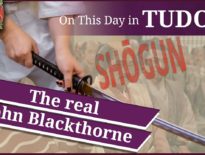On this day in Tudor history, 15th May 1537, Thomas Darcy, 1st Baron Darcy de Darcy, and his cousin, John Hussey, 1st Baron Hussey of Sleaford, were tried for treason at Westminster after being implicated in the Pilgrimage of Grace rebellion.
Both men may have been sympathetic to the rebel cause, but there was no actual evidence that they conspired against the king. Poor men!
Find out more about them and how they ended up being branded rebels, and what happened next, in today's talk.
Also on this day in Tudor history, 15th May 1567, the recently widowed Mary, Queen of Scots, married for the third time, taking James Hepburn, Earl of Bothwell and Duke of Orkney, as her husband. Find out more in last year’s video:
And on this day in 1536, Queen Anne Boleyn and her brother, George Boleyn, Lord Rochford, were tried by a jury of their peers presided over by their own uncle, the Duke of Norfolk. Did they have any hope of justice? What happened? What do the contemporary sources tell us? And what happened when George disobeyed an order? Find out in the 15 May 1536 video:
More Pilgrimage of Grace talks:
Also on this day in history:
- 1464 – Execution of Henry Beaufort, 2nd Duke of Somerset, immediately after the Battle of Hexham. He was buried in Hexham Abbey.
- 1536 – Chapuys reported that Jane Seymour received a message from the King that morning telling her that “he would send her news at 3 o’clock of the condemnation of the putain.”
- 1555 – Death of Sir Thomas Bromley, judge. Mary I made him her first Chief Justice of the Queen's Bench, but was unhappy when Nicholas Throckmorton was acquitted in 1554.
- 1556 – John Knox appeared in Edinburgh to face heresy charges.
Transcript:
On this day in Tudor history, 15th May 1537, Thomas Darcy, 1st Baron Darcy de Darcy, and his cousin, John Hussey, 1st Baron Hussey of Sleaford, were tried for treason at Westminster after being implicated in the Pilgrimage of Grace.
If you listened to my 20th October talk on the surrender of Pontefract Castle, you’ll know that on that day in 1536, Lord Darcy had yielded his castle to the rebels of the Pilgrimage of Grace after they had threatened an assault on it. No violence was necessary and it is thought that Darcy was sympathetic to the rebel cause anyway, because of his reservations about the dissolution of the monasteries and the power of Thomas Cromwell.
John Hussey, 1st Baron Hussey of Sleaford, Lincolnshire, and Chief Butler of England, was a staunch Catholic and supporter of the Princess Mary, but when rebellion had broken out in his county in late 1536 he told the rebels to “walk home knaves, for the king is used not to condition with no such rebellious” and that he refused to betray his king by joining them. He even fled disguised as a priest to try and stop the rebels taking him. However, his faith, his support for Princess Mary, and what was seen as his inaction against the rebels in his area, led to him being implicated in the rebellion and accused of conspiring and rebelling against the king.
Darcy and Hussey were tried on this day in 1537 by a jury of their peers preceded over by the Marquess of Exeter as High Steward of England. A record in the Letters and Papers of Henry VIII’s reign shows that both men pleaded not guilty, but that they were both found guilty of high treason. The sentence was “Judgment as usual in cases of high treason. Execution to be at Tyburn”, i.e. they were sentenced to the full traitor’s death, to be hanged, drawn and quartered. However, their sentences were commuted to beheading, due to their status as barons. It was decided that Hussey would be executed in Lincolnshire, so he was escorted to Huntingdon by Sir Thomas Wentworth, who then handed him over to Sir William Parr, who took him to Lincoln and handed him over to Charles Brandon, Duke of Suffolk. He was beheaded in Lincoln on 29th June 1537. Darcy was beheaded on Tower Hill in London the following day, 30th June 1537.


Lord Thomas Darcy had been the Warden in the North for many years, defending the gates to the North through Pontefract under both Henry vii and Henry Viii. He didn’t want to join the rebels but the castle could not hold against all of them and he was reluctant to spill the blood of his fellow Englishmen.
He let them into the castle and he was in talks with them but he ended up making a peace with them and in fact he gave them protection while the negotiations went on. However, Henry interpreted that as a betrayal and as he had sided or protected rebels, which by letting armed rebels into the castle contrary to the King’s orders he had betrayed his oath of loyalty. The King summoned him to London and he tried not to go because he was old and ill and he still had to go. He was excluded from the original pardons and may have been implicated in the second rebellion, but the evidence was vague. He was a man of long service but Henry’s religious reforms and the closures of religious houses took a huge toll in the North. He was one of many who not only sympathized but colluded with the rebels as a matter of principle. His death was the sad end to a long career.
Lord Hussey seems a bit of an enigma to me. He was condemned for something he wrote in a letter, but it wasn’t clear. He was implicated on very flimsy evidence. He also had a long career and again it was not a good end.